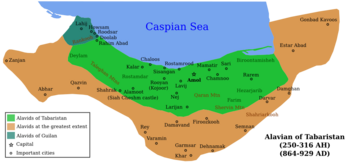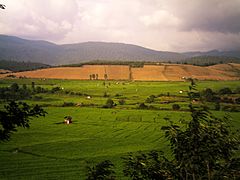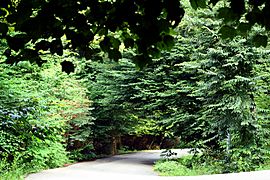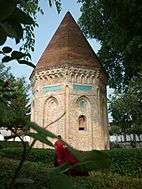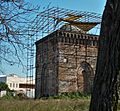Mazandaran province facts for kids
Quick facts for kids
Mazandaran province
استان مازندران
|
|
|---|---|
|
|
|

Location of Mazandaran province in Iran
|
|
| Country | Iran |
| Region | Region 1 |
| Capital | Sari |
| Counties | 22 |
| Area | |
| • Total | 23,833 km2 (9,202 sq mi) |
| Population
(2016)
|
|
| • Total | 3,073,943 |
| • Density | 128.9784/km2 (334.053/sq mi) |
| Time zone | UTC+03:30 (IRST) |
| ISO 3166 code | IR-02 |
| Main language(s) | Mazandarani(Tabari) |
| HDI (2017) | 0.845 very high · 4th |
Mazandaran province (, Persian: استان مازندران, romanized: Ostân-e Mâzandarân; Mazanderani: مازرون, romanized: Mâzerun) is one of Iran's 31 provinces. It is located along the southern coast of the Caspian Sea. It also sits near the central Alborz mountain range in northern Iran. The province covers an area of about 23,842 square kilometers. It was officially created in 1937.
In 2016, Mazandaran had a population of over 3.2 million people. This makes it one of the most crowded provinces in Iran.
The province has many different natural resources. These include large amounts of oil and natural gas. Mazandaran has various natural places, from sandy beaches along the Caspian Sea to rugged, snow-covered Alborz mountains. This includes Mount Damavand, which is one of the highest peaks and volcanoes in Asia.
Mazandaran is a big producer of farmed fish. Aquaculture (raising fish in water) is an important part of its economy. This adds to the traditional strength of agriculture. Tourism is also a key industry. Many people from all over Iran love to visit this beautiful area. Mazandaran is also quickly becoming a center for biotechnology.
Contents
What's in a Name?
The name "Mazandaran" might mean "the gate or valley of the giants." It comes from old words meaning "giant" and "gate." The name has been used in the famous Persian book Shahnameh. In that book, Mazandaran was a land where giants (called divs) and sorcerers lived. It was known as a very hard place to conquer.
You can find places in Mazandaran today with "Div" in their names. For example, Div Asiyab, Div Cheshmeh, and Div Kela.
A Look Back in Time

People have lived in this area for at least 75,000 years. Recent digs at Gohar Tape in Rostamkola show that cities existed here over 5,000 years ago. This makes it one of Iran's most important historical places. It played a big role in the cultural and urban growth of the region. Mazandaran is one of the oldest areas where people settled down. They did not move around like nomads.
The original people of this region are the Mazanderanis. They speak an Iranian language called Mazandarani. This language is similar to Gilaki and Sangiseri. It also has sounds like some Caucasian languages. This shows the long history of the region and its people.
In the early 1900s, Reza Shah built seven new roads and railways. These connected the northern Elbourz mountains to the southern slopes. This made Mazandaran and Gilan provinces known as "Shomal" (meaning "the North") to all Iranians. Mazandaran is a Caspian province in northern Iran. It is on the southern coast of the Caspian Sea. It shares borders with Russia (across the sea), Golestan, Semnan, Tehran, Alborz, Qazvin, and Gilan provinces. Sari is the largest city and the capital of Mazandaran province.
In 2014, Mazandaran province became part of Region 1. This was done to help with coordination and development across Iran's provinces.

Ancient Times
Before people who spoke Iranian languages arrived, the native people here were hunters and cattle herders. Old studies in caves like Hutu Man in Behshahr show people lived here around 9500 BCE. The Amard tribe lived in the mountains near the Caspian Sea. This included the area of modern Amol. The Tapuri tribe lived south of the Caspian Sea.
The area of Mazandaran has been ruled by many different groups throughout history. There are old fortresses from the Parthian Empire and Sasanian Empire. Many old cemeteries are also found across the province. During these times, Mazandaran was part of Hyrcania, an important province.
In 662 CE, a large Muslim army tried to invade Tabarestan. This was ten years after the last Sasanian emperor died.
When the Sasanian Empire began, Gushnasp was the King of Mazandaran. His family had ruled the area for a long time. In 529–536, a Sasanian prince named Kawus ruled Mazandaran. This family ruled until 645 AD. Then, Gil Gilanshah joined Mazandaran with Gilan.
In 651, the Sasanid Empire fell. Most of its lands came under Arab rule. But the Caspian region of Iran, including Tabaristan, stayed independent for a while.
Islamic Era
Tabaristan remained separate from the Umayyad Caliphate. This was the Muslim empire that took over from the Sasanians. Local Zoroastrian families fought against Islam. A short-lived Shiite state also existed. Unlike most of Iran, Mazandaran kept a majority of Zoroastrians until the 12th century. This was because it was isolated and its people were strong fighters.
After the Islamic period, local ruling families were of three types. Some were old families from before Islam. Others were descendants of the Prophet Muhammad (called Alid sayyid). And some were other local families.
The Bawandids were one of these ruling families. They ruled in three different periods. The first period was from 665 to 1007. The second was from 1073 to 1210. The third ruled from 1237 to 1349. They were under the control of the Mongols during this time.
In the 9th to 11th centuries, Rus' people often raided the Caspian Sea shores. They traveled as merchants along the Volga trade route. They sold furs, honey, and slaves. The first big raid happened in 913. About 500 ships arrived. They looted parts of Gorgan, Mazandaran, and Gilan. They took slaves and goods.
During the Safavid era, many Georgians, Circassians, and Armenians settled in Mazandaran. Their families still live there today. Many towns and villages still have "Gorji" (meaning Georgian) in their names. Most of these groups have now blended in with the local Mazandaranis.
Before Nader Shah ruled, the Russian army briefly took over the province. This was after a war in 1722–23. It was given back to Persia in 1735. Later wars with Russia in the 1800s meant that northern Iran, including Mazandaran, came under Russian influence.
Modern Times
During the rule of Fath-Ali Shah Qajar, Mazandaran was seen as a beautiful place for fun. The region remained independent until 1596. Then, Shah Abbas I made Mazandaran part of his Safavid empire. He made many Armenians, Circassians, and Georgians move to Mazandaran. A traveler named Pietro della Valle visited a town near Firuzkuh. He wrote that Mazandarani women did not wear veils. He also said they were very polite to strangers.
Today, Persia proper, Fars, Mazanderan on the Caspian Sea and many other lands of this empire are all full of Georgian and Circassian inhabitants. Most of them remain Christian to this day, but in a very crude manner, since they have neither priest nor minister to tend them.
—Pietro Della Valle
After the Safavid period, the Qajars began to expand from Mazandaran. Agha Mohammad Khan made Mazandaran part of his empire in 1782. On March 21, 1782, he made Sari his capital city. Mazandaran saw many local wars during these years. This led to the capital being moved from Sari to Tehran by Fath Ali Shah. Today, many new houses and bridges are built in Amol and Sari. Along the beach and in the forests, you can see many villas and modern homes.
Mazandaran has three international airports and three major sea ports. Millions of Iranian and foreign tourists visit the province each year. Many come for health tourism.
Geography and Nature
Mazandaran is on the southern coast of the Caspian Sea. It borders Golestan, Semnan, and Tehran provinces. It also borders Qazvin and Gilan to the west.
Mazandaran province has two main parts: the coastal plains and the mountains. The Alborz Mountain Range forms a huge wall around the coastal strip and the plains near the Caspian Sea. Sea breezes and local winds create sandy hills. These hills form a low natural barrier between the sea and the plains. Snow often falls in the Alborz regions. These mountains run next to the Caspian Sea's southern coast. They divide the province into many separate valleys. The province has a mild, subtropical climate. The average temperature is 25 °C in summer and about 8 °C in winter. Snow can fall heavily in the mountains in winter, but it rarely snows at sea level.
-
Damavand Mountain, The West Face, Mazandaran Province, Iran
Mazandaran has two main types of natural areas:
- Caspian Hyrcanian mixed forests
- Elburz Range forest steppe
The total wood from these forests is about 269,022 cubic metres (9,500,400 cu ft). The Hyrcanian forest covers about 965,000 ha (2,380,000 acres). Some parts are used for business, some are protected, and others are forest lands.
The Elburz Range forest steppe is a dry, mountainous area. It stretches for 1,000 kilometers south of the Caspian Sea. It covers about 63,300 square kilometres (24,400 sq mi). This area includes the southern and eastern slopes of the Alborz Mountains. The climate is dry, with rain mostly as winter snow.
Wildlife and Environment
The now extinct Caspian tiger and the Caspian horse once lived in Mazandaran province.
The 1971 Ramsar Convention was held in the city of Ramsar. This important meeting was about protecting wetlands around the world.
 |
Caspian Sea | Caspian Sea | Caspian Sea |  |
| Gilan province Qazvin province | Golestan province | |||
| Alborz province | Tehran province | Semnan province |
Mazandaran has many rivers and mountain streams. These flow from the mountains to the sea. A German traveler in 1771 noted 250 such streams in just eight miles. Some were so wide and deep that crossing them was impossible for weeks.
Climate

Mazandaran's climate is shaped by its location, the Alborz mountains, and its distance from the sea. These factors create three types of climate:
- Moderate Caspian weather: Hot, humid summers and mild, humid winters. This is found in the western and central plains.
- Moderate mountainous weather: Long, cold, freezing winters and mild, short summers. This is found at altitudes of 1,500 to 3,000 meters.
- Cold mountainous weather: Long, freezing winters and short, cool summers. Snow often falls here, even into mid-summer.
How Mazandaran is Divided
Mazandaran is split into 22 counties. Each county is named after its main town. However, North Savadkuh County (Shirgah), Savadkuh County (Pol-e Sefid), and Simorgh County (Kiakola) are exceptions.
| Administrative Divisions | 2006 | 2011 | 2016 |
|---|---|---|---|
| Abbasabad County1 | — | 47,591 | 52,832 |
| Amol County | 343,747 | 370,774 | 401,639 |
| Babol County | 464,538 | 495,472 | 531,930 |
| Babolsar County | 172,600 | 124,323 | 135,191 |
| Behshahr County | 154,957 | 155,247 | 168,769 |
| Chalus County | 119,559 | 122,736 | 116,542 |
| Fereydunkenar County2 | — | 57,980 | 60,031 |
| Galugah County | 39,450 | 38,847 | 40,078 |
| Juybar County | 70,204 | 73,554 | 77,576 |
| Kelardasht County3 | — | — | 23,648 |
| Mahmudabad County | 90,054 | 96,019 | 98,407 |
| Miandorud County4 | — | 55,776 | 55,053 |
| Neka County | 104,753 | 111,944 | 119,511 |
| North Savadkuh County5 | — | — | 24,834 |
| Nowshahr County | 116,334 | 128,647 | 138,913 |
| Nur County | 104,807 | 109,281 | 121,531 |
| Qaem Shahr County | 293,721 | 320,741 | 309,199 |
| Ramsar County | 67,675 | 68,323 | 74,179 |
| Sari County | 490,830 | 478,370 | 504,298 |
| Savadkuh County | 66,430 | 64,378 | 43,913 |
| Simorgh County6 | — | — | 19,376 |
| Tonekabon County | 193,428 | 153,940 | 166,132 |
| Total | 2,893,087 | 3,073,943 | 3,283,582 |
| 1Separated from Tonekabon County 2Separated from Babolsar County 3Separated from Chalus County 4Separated from Sari County 5Separated from Savadkuh County 6Separated from Qaem Shahr County |
|||
Major Cities
Over 57% of Mazandaran's people live in cities. Here are some of the largest:
| Rank | City | County | Population |
|---|---|---|---|
| 1 | Sari | Sari | 309,820 |
| 2 | Babol | Babol | 250,217 |
| 3 | Amol | Amol | 237,528 |
| 4 | Qaem Shahr | Qaem Shahr | 204,953 |
| 5 | Behshahr | Behshahr | 94,702 |
| 6 | Chalus | Chalus | 65,196 |
| 7 | Neka | Neka | 60,991 |
| 8 | Babolsar | Babolsar | 59,966 |
| 9 | Tonekabon | Tonekabon | 55,434 |
| 10 | Nowshahr | Nowshahr | 49,403 |
| 11 | Fereydunkenar | Fereydunkenar | 38,154 |
| 12 | Ramsar | Ramsar | 35,997 |
People and Languages
The number of people living in Mazandaran has grown steadily over the last 50 years.
Most people in Mazandaran are Mazandarani. There are also smaller groups like Gilaks, Azerbaijanis, Kurds, Georgians, Armenians, Circassians, and Turkmen.
Mazandarani people are from the Tabari ethnic group. They speak the Mazandarani language. Their history goes back to the Tapuri people. This is why their land was once called Tapuria. The Tapuris were made to move to the south coast of the Caspian Sea long ago.
The native people of Sari, Shahi, Babol, Amol, Nowshahr, Chalus, and Tonekabon are Mazandarani. They speak the Mazandarani language.
The eastern Gilaki dialect is spoken in the valley of the Čālūs river. Kurdish tribes also settled in the Kojūr and Kalārdašt areas. Today, Kurds in Mazandaran are mostly known as Khajevand Kurds. They make up most of the population in cities like Kelardasht, Abbasabad, Nowshahr, Chalus, and Kajur.
The Gilaks are the largest minority group in Mazandaran. They speak the Gilaki language. They mostly live in Ramsar and Tonekabon. The Gilaki spoken in Ramsar has been influenced by the Mazandarani language.
A dialect of Azeri is spoken in the town of Galoogah.
Getting Around Mazandaran
Train Travel
The Mazandaran train station was the first modern rail station in the city. It was built during the Pahlavi dynasty.
Roads
Mazandaran is connected to Tehran by three main roads:
- Haraz road (between Amol and Rudehen)
- Kandovan road (between Chalus and Karaj)
- Firoozkooh road (through Savadkuh)
Airports
Mazandaran has domestic airports that connect it to other parts of Iran:
- Dasht-e Naz Airport (serving the capital Sari)
- Noshahr Airport
- Ramsar International Airport
Railway
The North Railway Department of the Iranian Railways serves Mazandaran. This railway connects the province to Tehran in the south and Gorgan in the east. The cities of Sari, Qaemshahr, and Pol-e Sefid are important stations. The Trans-Iranian Railway was a huge project. It started in 1927 and finished in 1938. Reza Shah led this project, and it was built entirely with money from Iran. It links Tehran with the Persian Gulf and the Caspian Sea.
Culture and Fun
In the famous Persian epic, Shahnameh, Mazandaran is mentioned in two parts. First, Fereydun sets his capital in Tamishe near Amol. Later, the hero Manuchehr returns to this capital after a victory.
In another part, a region called Mazandaran is mentioned during the time of Kai Kavoos. This area is mostly home to Div (demons). The legendary Iranian Shah Kaykavoos and the hero Rostam both go to Mazandaran to fight these demons.
However, this Mazandaran in the Shahnameh is not the same as the modern province. It is thought to be a land to the west of Iran. The current province was known as Tabaristan. The name Mazandaran came later.
In Gaston Leroux's book The Phantom of the Opera, one character used to be the police chief of Mazanderan.
New Year Traditions
The Tabarian New Year, or Neowrez, happens during the pintek days of the Tabarian Calendar. In the Mazandarani language, the year has 12 months of 30 days each, plus five extra days. It often starts on March 21. Neowrez Khani is a very strong and popular tradition of the Mazanderani people.
Festivals and Events
Tirgan is a mid-summer Iranian festival. It is celebrated every year on Tir 13 (July 3, 4, or 5). People celebrate by splashing water, dancing, and reciting poetry. They also eat traditional foods like spinach soup. Children tie rainbow-colored bands on their wrists. They wear them for ten days, then throw them into a stream. Other famous events include Varf Chal, an almost 800-year-old water ceremony. There is also Lochu Wrestling.
Music and Dance
Music in Mazandaran is connected to the daily lives of its people. The songs are often about forests, farming, and herding. The most famous dance here is the Shomali dance. Men also perform a stick dance. Popular music styles include Taleb and Zohre, Amiri Khani, and Katuli.
Tourism Hotspot
Over 15 million Iranian tourists visit Mazandaran every year. About 400,000 foreign tourists also come. The province has more than 800 registered historical and cultural sites. It also has 338 kilometers of shorelines, mineral springs in jungles and mountains, waterfalls, and caves. These are some of Mazandaran's main attractions. Mazandaran was chosen as the tourism capital for the Economic Cooperation Organization (ECO) member states in 2022. Mazandaran has many places for tourists to stay. These include 65 hotels, 51 motels, and 91 apartment hotels. There are also 293 eco-lodge complexes and 4,939 guest houses.
Places to See
- Mount Damavand
- Abbas Abad Garden, Behshahr
- Mausoleum of Mir Bozorg
- Kandolus
- Tomb of Haydar Amuli
- Safi Abad Palace
- Ramsar Palace
- Malek Bahman Castle
- Veresk Bridge
- Lar Dam
- Alam-Kuh
- Lar National Park
- Badab-e Surt
- Shahrak-e Namak Abrud
- Huto and Kamarband Caves
- Nassereddin Shah relief
- Jameh Mosque of Amol
- Elburz Range forest steppe
- Shahandasht Waterfall
- Shoormast Lake, Savadkuh
- Kelardasht
Famous People from Mazandaran
Many important people in different fields come from Mazandaran province.
Writers and Poets
- Muhammad ibn Jarir al-Tabari (838-923), a famous historian and theologian.
- Ibn Isfandiyar, who wrote a history of Tabaristan.
- Nima Youshij, a well-known poet.
- Taleb Amoli, another famous poet.
Musicians
- Gholam Hossein Banan, a great singer.
- Delkash, a popular singer.
- Shervin Hajipour, a modern musician.
Architects
- Omar Tiberiades (d.c.815), an astrologer and architect.
- Abolhassan Sadighi, a famous sculptor and painter.
Film and TV Stars
- Shahab Hosseini, a well-known actor.
- Davoud Rashidi, a respected actor.
- Mostafa Zamani, a popular actor.
- Roya Nonahali, a famous actress.
Scientists and Scholars
- Ali ibn Sahl Rabban al-Tabari, a physician and scholar.
- Fakhr al-Din al-Razi, a theologian and philosopher.
- Hassan Hassanzadeh Amoli, an Islamic scholar.
- Baháʼu'lláh, the founder of the Baháʼí Faith.
Athletes
- Abdollah Movahed, a wrestling legend.
- Behdad Salimi, a strong weightlifter.
- Hassan Yazdani, a famous wrestler.
- Farhad Majidi, a popular footballer.
- Alireza Firouzja, a chess grandmaster.
Important Figures
- Reza Shah Pahlavi, Shah of Iran from 1925 to 1941.
- Mohammad Reza Pahlavi, the last Shah of Iran.
- Abbas the Great Shah, a powerful Safavid ruler.
- Ali Larijani, a notable politician.
- Mohammad Vali Khan Tonekaboni, a historical political figure.
Mazandaran Today
Delicious Food
The food in Mazandaran is rich in seafood. This is because it is located by the Caspian Sea. Rice is eaten with almost every meal. The food changes depending on the region. Coastal areas use fish, while mountain areas use local herbs.
Economy and Industry
Mazandaran is one of the five richest provinces in Iran. Its oil wealth has helped industries like food processing, cement, textiles, and fishing (especially caviar). Iran's Cultural Heritage Organization lists nearly 630 historical and cultural sites here. Many of these attract tourists. Farmers in the lowlands grow Rice, grains, fruits, cotton, tea, tobacco, and sugarcane. They also produce Flowers, Mineral water, caviar, Dairy products, and silk. Mazandaran produces about one million tons of rice each year. This is 42% of Iran's total rice production. It also meets 50% of the country's citrus fruit needs. The province is the only place in Iran that produces kiwi. Mazandaran has 3,500 industrial and production units. It has 460,000 hectares of farmland. This land produces about 6 million tons of farm products every year. Over 10% of the value added in Iran's agriculture comes from Mazandaran.
Exports
In 2017, Mazandaran exported goods worth almost $800 million. Half of these were exported from customs outside the province. The main exports were dairy products (57%), food products (12%), industrial goods (10%), pipes and profiles (8%), and cement (7%). Mazandaran exports to countries like Germany, Russia, Iraq, France, Turkey, India, and the United Arab Emirates.
Innovation and Growth
Mazandaran is quickly becoming a center for tourist activities, innovation, biotechnology, and civil engineering.
Oil and Gas
From 1951 to 1978, many wells were drilled near mud volcanoes. These wells mostly produced natural gas. However, it was found that continuing these operations would not be profitable. Mazandaran exports 10 thousand tons of oil and an unknown amount of gas to Asian countries.
Key Facts
- 9th in Iran for industrial units.
- 5th in Iran for general industry.
- 4th in Iran for tooling machines.
- 2nd in Iran for coal.
- 1st in Iran for livestock and agricultural products.
- 1st in Iran for granite.
- 1st in Iran for fluorine.
- 1st in Iran for flowers and ornamental plants.
- 1st in Iran for citrus exports.
- 1st in Iran for food product exports.
Schools and Universities
Some of the main universities in Mazandaran are:
- University of Mazandaran, Babolsar
- Mazandaran University of Medical Sciences, Sari
- Babol Noshirvani University of Technology, Babol
- Sari Agricultural Sciences and Natural Resources University, Sari
- Shomal University, Amol
Sports
Mazandaran has won 19% of Iran's medals in the Olympics. This is the largest share among all provinces. They have won 7 gold, 4 silver, and 4 bronze medals. For many years, Mazandaran has produced many great wrestlers. Football and volleyball are also very popular. Many players from Mazandaran play in the Premier League and the national team. Other successful sports include weightlifting, Taekwondo, table tennis, boxing, and karate. Some famous teams from the province are Kalleh Mazandaran VC, Shamoushak Noshahr F.C., and F.C. Nassaji Mazandaran. Kalleh has won the Iranian Volleyball Super League Championship twice.
Sister Provinces
Mazandaran has friendly relationships with other regions around the world:
 Astrakhan, Russia
Astrakhan, Russia Marche, Italy
Marche, Italy Dar es Salaam, Tanzania
Dar es Salaam, Tanzania Issyk-Kul, Kyrgyzstan
Issyk-Kul, Kyrgyzstan Mekong Delta, Vietnam
Mekong Delta, Vietnam
Images for kids
-
Riding a watercraft in Ramsar
-
Fire Temple of Amol
-
Museum of Reza Shah Pahlavi at Alasht
-
Reza Shah House
See Also
 In Spanish: Provincia de Mazandarán para niños
In Spanish: Provincia de Mazandarán para niños
- Mazandarani people
- List of Mazanderanis
- Amardi
- Sasanian dynasty
- Maziar
- Tabaristan
- Dabuyid dynasty
- Pahlavi dynasty
- Alborz (Elburz) mountain range topics














